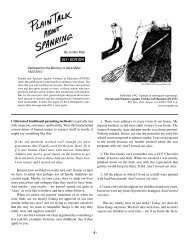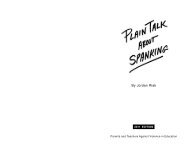Plain Talk About Spanking - Project NoSpank
Plain Talk About Spanking - Project NoSpank
Plain Talk About Spanking - Project NoSpank
You also want an ePaper? Increase the reach of your titles
YUMPU automatically turns print PDFs into web optimized ePapers that Google loves.
Neglect and permissiveness<br />
Defenders of spanking often argue that a caretaker’s only choice is<br />
between spanking and doing nothing. That’s a false choice. Permissiveness<br />
is as unwise and counterproductive as hitting. The wise caretaker<br />
establishes a safe environment with age-appropriate boundaries and<br />
reasonable rules, models called-for behaviors, and appeals to and cultivates<br />
the child’s natural inclination toward imitation and cooperation. This method<br />
takes more skill and patience than hitting, but it works. It strengthens the<br />
bond of trust between parent and child, between teacher and learner, thus<br />
paving the way for the more challenging lessons ahead.<br />
Spousal battery and spanking<br />
In the overwhelming majority of cases, husbands and wives whose<br />
relationships include violence are also violent toward their children. Such<br />
people surely were spanked when they were little and likely witnessed<br />
others being spanked.<br />
Battering and battered spouses who spank their children are raising<br />
them to become batterers and victims exactly like themselves. The children<br />
learn from the parents’ example that the way to vent frustration, express<br />
disapproval and assert authority is by hitting someone smaller and weaker<br />
than themselves. They see this principle demonstrated every time they<br />
witness their parents come to blows, as well as every time they are on the<br />
receiving end of violent punishments. They learn that once they are big<br />
enough and strong enough, they can control others by threatening or hurting<br />
them. They learn that it is okay for husbands and wives to mistreat each<br />
other and for adults to mistreat children.<br />
When children, whose personalities have been formed in violent<br />
households, grow up and have children of their own, they find it very<br />
difficult to break free from the behaviors they have witnessed and<br />
experienced. The skills they apply to family life will be the poor ones they<br />
learned from their parents, and they are likely to perpetuate the cycle of<br />
abuse through their own innocent children.<br />
As spanking disappears from family life, other forms of domestic<br />
violence will also disappear.<br />
Escalation<br />
Physical injuries and deaths of children caused by their caretakers often<br />
are the consequence of physical punishment. Perpetrators of even the most<br />
horrendous acts against children typically explain that the child’s<br />
misbehavior called for punishment, and the outcome was unintended.<br />
“Accidental” is the child abuser’s all-weather alibi.<br />
4





